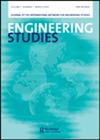Editorial
IF 1.3
3区 工程技术
Q2 EDUCATION, SCIENTIFIC DISCIPLINES
引用次数: 0
Abstract
Greetings for a new year and a new volume of Engineering Studies. Issue 11.1 has some exciting content, all broadly concerned with how to educate interdisciplinary engineers who will be more attuned to societal context in their design practices. Yet despite that common thread, this issue’s two articles, one Report, and one Critical Participation piece approach the topic from very different directions. That diversity in striving toward a common aim is one of the strengths of this field and its journal. The most personal of this issue’s contributions is our Critical Participation piece, ‘Interdisciplinarity in Practice: Reflections on Drones as a Boundary Object’, by Elizabeth Reddy, Gordon Hoople, and Austin Choi-Fitzpatrick. The authors describe a course at the University of San Diego created by Hoople (a faculty member in USD’s School of Engineering) and Choi-Fitzpatrick (a faculty member in USD’s School of Peace). The point of the course was to foster an interdisciplinary environment in which engineering and peace studies students would teach and learn from each other and cause each other to question their own assumptions. Reddy, as a postdoctoral fellow and cultural anthropologist supported at USD by the National Science Foundation, approached the course as an ethnographic field site where she could interact with the students and facultymembers participating in one of the projects funded byNSF’s Revolutionizing Engineering and Computer Science Departments program. Hoople andChoi-Fitzpatrick assigned the students to develop a ‘drone thatmight have a positive social impact’, on the theory that ‘drones’ (a popular rather than technical category) are a controversial technology thatwould nudge the students toward frank and productive interdisciplinary debates. Unfortunately, the interdisciplinary ideals of the course fell somewhat short in practice. Instead of the peace studies students prompting the engineering students to take amore critical stance, in practice the presence of the engineering students seems to have given the peace studies students leeway to take a less critical stance. Fortunately, the authors take that setback as an opportunity to reflect on what happened, draw some lessons, and put their experiences in front of the engineering studies community for further discussion. One thing I like about this article is that it reinforces the long-standing ties between peace studies and engineering studies; these are fields that ought to be natural allies.1 But intellectuallywhat I find exciting here is the intersection of two forefront topics in engineering studies and related fields. On one side, there is now a fast-growing critical literature on interdisciplinarity. For many years now, ‘interdisciplinary’ has been used as a synonym for ‘good’ on many university campuses, especially but not only in North America. And interdisciplinarity can be a force for good, as this journal tries to demonstrate. But it is not an automatic good, and it somecases it canevenbecounterproductive to its promoters’ aims.2 We need a critical understanding of interdisciplinarity if it is to do the things claimed for it – and articles like this one are an important contribution to that.社论
恭贺新的一年和新一期的《工程研究》。第11.1期有一些令人兴奋的内容,都是关于如何教育跨学科的工程师,使他们在设计实践中更加适应社会环境。然而,尽管有这些共同的线索,本期的两篇文章,一篇报告和一篇关键参与从非常不同的方向来探讨这个主题。朝着共同目标努力的多样性是这一领域及其期刊的优势之一。本刊最个人的贡献是我们的关键参与作品,“实践中的跨学科:对无人机作为边界对象的反思”,作者是Elizabeth Reddy, Gordon Hoople和Austin Choi-Fitzpatrick。作者描述了圣地亚哥大学的一门课程,该课程是由Hoople(美国工程学院的教员)和Choi-Fitzpatrick(美国和平学院的教员)共同创建的。这门课程的重点是培养一个跨学科的环境,在这个环境中,工程学和和平研究的学生将相互教授和学习,并使彼此质疑自己的假设。雷迪是美国国家科学基金会资助的博士后研究员和文化人类学家,她把这门课作为人种学领域的一个站点,在那里她可以与参与国家科学基金会“革命性工程和计算机科学系”项目的学生和教师互动。胡普尔和崔-菲茨帕特里克要求学生们开发一种“可能产生积极社会影响的无人机”,他们的理论是,“无人机”(一种流行而非技术类别)是一种有争议的技术,它将推动学生们进行坦率而富有成效的跨学科辩论。不幸的是,这门课程的跨学科理想在实践中有些不足。而不是和平研究的学生促使工程专业的学生采取更多的批评立场,在实践中,工程专业的学生的存在似乎给和平研究的学生采取较少的批评立场的余地。幸运的是,作者把这个挫折作为一个机会来反思所发生的事情,吸取一些教训,并把他们的经验放在工程研究社区的前面进行进一步的讨论。我喜欢这篇文章的一点是,它加强了和平研究与工程研究之间的长期联系;这些领域应该是天然的盟友但在智力上,我发现令人兴奋的是工程研究和相关领域的两个前沿主题的交集。一方面,现在有一个快速增长的跨学科批判性文献。多年来,在许多大学校园里,“跨学科”一直被用作“好”的同义词,尤其是在北美,但不仅仅是在北美。正如本杂志试图证明的那样,跨学科可以成为一种积极的力量。但这并不是一件自然而然的好事,有时甚至会对其推动者的目标产生反作用我们需要对跨学科有一个批判性的理解,如果它要做到它所要求的事情——像这篇文章这样的文章是一个重要的贡献。
本文章由计算机程序翻译,如有差异,请以英文原文为准。
求助全文
约1分钟内获得全文
求助全文
来源期刊

Engineering Studies
ENGINEERING, MULTIDISCIPLINARY-HISTORY & PHILOSOPHY OF SCIENCE
CiteScore
3.60
自引率
17.60%
发文量
12
审稿时长
>12 weeks
期刊介绍:
Engineering Studies is an interdisciplinary, international journal devoted to the scholarly study of engineers and engineering. Its mission is threefold:
1. to advance critical analysis in historical, social, cultural, political, philosophical, rhetorical, and organizational studies of engineers and engineering;
2. to help build and serve diverse communities of researchers interested in engineering studies;
3. to link scholarly work in engineering studies with broader discussions and debates about engineering education, research, practice, policy, and representation.
The editors of Engineering Studies are interested in papers that consider the following questions:
• How does this paper enhance critical understanding of engineers or engineering?
• What are the relationships among the technical and nontechnical dimensions of engineering practices, and how do these relationships change over time and from place to place?
 求助内容:
求助内容: 应助结果提醒方式:
应助结果提醒方式:


